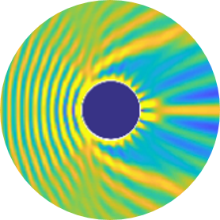The surface under study can be meshed using low order flat triangular elements or higher order 10-edge quadrilateral elements. To solve electrical large problems, multi-level fast multipole method (MLFMM) is normally employed. For the simulator it was implemented using an octree data structure. The coupled electric and magnetic surface integral equations were then solved with an iterative algorithm of GMRES.
The figure below shows the capability of the Simulator through two examples. One is a silver plate (2.5 2.5 µm2) with a hole in it (D = 1.0 µm). The surface was meshed using COMSOL Multiphysics by 3193 elements as shown in (a). Under the illumination of a p-polarized Gaussian beam propagating along the z-direction at a wavelength of 600 nm, the scattered field intensity in the incident plane is shown in (b). Using the combination of MLFMM and GMRES, 69 iterations was used for this surface to achieve an iterative residual error of 10-3. The consumed time on a server with 12 threads (2× Xeon E5-2627, 3.5GHz) was 36 seconds. Light scattering from a 3D object is further tested. A silver sphere with a diameter of 2 µm was meshed with a mesh size of 30 nm and 17291 elements, as shown in (c). This leads to 51867 unknowns. Totally, 280 iterations was used to achieve a residual error of 10-3. For this case, the illumination is a plane wave. The calculated field intensity in the incident xz-plane is compared with that from the Mie-calculation and both are shown in (d). Identical results within in an error range are obtained in both the near field and far field region.
Description of Figures:
(a) a meshed Ag surface with a hole of D = 1.0 µm at the center is illuminated by a Gaussian beam with a beam waist of 1.5µm at nm. The light propagates along the z-direction. (b) Scattered field intensity from the Ag surface in (a). (c) A silver sphere with a diameter of 2 µm meshed by COMSOL Multiphysics with 17291 flat triangular elements. (d) Scattered field intensities calculated by the Speckle simulator and Mie theory. Left: the Speckle simulator and Right: Mie-calculation. The sphere is illuminated by a plane wave.
Verantwortliche:

Liwei Fu
Dr.Wissenschaftliche Mitarbeiterin







